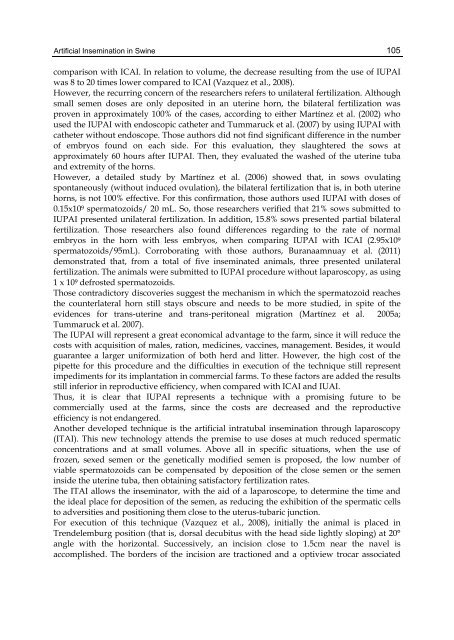ARTIFICIAL INSEMINATION IN FARM ANIMALS - Phenix-Vet
ARTIFICIAL INSEMINATION IN FARM ANIMALS - Phenix-Vet
ARTIFICIAL INSEMINATION IN FARM ANIMALS - Phenix-Vet
You also want an ePaper? Increase the reach of your titles
YUMPU automatically turns print PDFs into web optimized ePapers that Google loves.
Artificial Insemination in Swine 105comparison with ICAI. In relation to volume, the decrease resulting from the use of IUPAIwas 8 to 20 times lower compared to ICAI (Vazquez et al., 2008).However, the recurring concern of the researchers refers to unilateral fertilization. Althoughsmall semen doses are only deposited in an uterine horn, the bilateral fertilization wasproven in approximately 100% of the cases, according to either Martínez et al. (2002) whoused the IUPAI with endoscopic catheter and Tummaruck et al. (2007) by using IUPAI withcatheter without endoscope. Those authors did not find significant difference in the numberof embryos found on each side. For this evaluation, they slaughtered the sows atapproximately 60 hours after IUPAI. Then, they evaluated the washed of the uterine tubaand extremity of the horns.However, a detailed study by Martínez et al. (2006) showed that, in sows ovulatingspontaneously (without induced ovulation), the bilateral fertilization that is, in both uterinehorns, is not 100% effective. For this confirmation, those authors used IUPAI with doses of0.15x10 9 spermatozoids/ 20 mL. So, those researchers verified that 21% sows submitted toIUPAI presented unilateral fertilization. In addition, 15.8% sows presented partial bilateralfertilization. Those researchers also found differences regarding to the rate of normalembryos in the horn with less embryos, when comparing IUPAI with ICAI (2.95x10 9spermatozoids/95mL). Corroborating with those authors, Buranaamnuay et al. (2011)demonstrated that, from a total of five inseminated animals, three presented unilateralfertilization. The animals were submitted to IUPAI procedure without laparoscopy, as using1 x 10 9 defrosted spermatozoids.Those contradictory discoveries suggest the mechanism in which the spermatozoid reachesthe counterlateral horn still stays obscure and needs to be more studied, in spite of theevidences for trans-uterine and trans-peritoneal migration (Martínez et al. 2005a;Tummaruck et al. 2007).The IUPAI will represent a great economical advantage to the farm, since it will reduce thecosts with acquisition of males, ration, medicines, vaccines, management. Besides, it wouldguarantee a larger uniformization of both herd and litter. However, the high cost of thepipette for this procedure and the difficulties in execution of the technique still representimpediments for its implantation in commercial farms. To these factors are added the resultsstill inferior in reproductive efficiency, when compared with ICAI and IUAI.Thus, it is clear that IUPAI represents a technique with a promising future to becommercially used at the farms, since the costs are decreased and the reproductiveefficiency is not endangered.Another developed technique is the artificial intratubal insemination through laparoscopy(ITAI). This new technology attends the premise to use doses at much reduced spermaticconcentrations and at small volumes. Above all in specific situations, when the use offrozen, sexed semen or the genetically modified semen is proposed, the low number ofviable spermatozoids can be compensated by deposition of the close semen or the semeninside the uterine tuba, then obtaining satisfactory fertilization rates.The ITAI allows the inseminator, with the aid of a laparoscope, to determine the time andthe ideal place for deposition of the semen, as reducing the exhibition of the spermatic cellsto adversities and positioning them close to the uterus-tubaric junction.For execution of this technique (Vazquez et al., 2008), initially the animal is placed inTrendelemburg position (that is, dorsal decubitus with the head side lightly sloping) at 20°angle with the horizontal. Successively, an incision close to 1.5cm near the navel isaccomplished. The borders of the incision are tractioned and a optiview trocar associated










